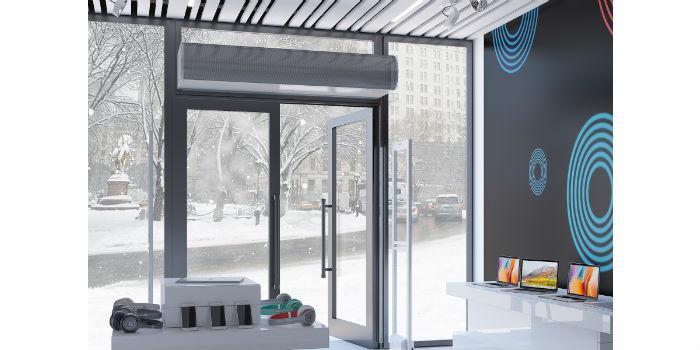 International. The use of door air curtains as alternatives to entrances at most commercial building entrances was recently approved, which will be stipulated in the upcoming ASHRAE Standard 90.1-2019 "Energy Standard for Buildings, Except Low-Rise Residential Buildings".
International. The use of door air curtains as alternatives to entrances at most commercial building entrances was recently approved, which will be stipulated in the upcoming ASHRAE Standard 90.1-2019 "Energy Standard for Buildings, Except Low-Rise Residential Buildings".
The professional association-approved addition requires the air curtain performance to be tested in accordance with ANSI/AMCA Standard 220 to ensure it provides a minimum of 400 feet/min air stream speed on the floor.
The approval is good news for owners of retail stores, health care, hospitality, offices and other facilities, as they can now choose to forego the expense of entrances on new construction, or reuse a large amount of square footage for more productive uses by modernizing existing entrances. Consultant engineers and architects, who were previously hesitant to supplant inlets with air curtains due to inconsistent code language, are now supported by ASHRAE Standard 90.1-2019 to be released this fall.
In addition, HVAC contractors will see an increase in air curtain installations to accommodate facilities that seek to prevent power loss through their main entrances and comply with building codes. Air curtains also protect against the infiltration of outside air, fumes, flying insects, wind and dust through open doors, and contribute to the air comfort of the occupants.
The additional Air Curtain Effectiveness team was sponsored by AMCA (International Air Movement and Control Association), a trade association based in Arlington Heights, Illinois, dedicated to certifying manufacturers' air performance statistics. "This is the most significant recognition of air curtains as an effective energy conservation device since air curtains were approved by the International Code of Conservation of Energy (IECC) as a substitute for lobby in 2015," said David Johnson, president of AMCA and director of air curtain engineering at manufacturer Berner International.
Inclusion in ASHRAE Standard 90.1 required more than eight years of research and presentations on air curtains. The IECC code and the high-performance overlay code, the International Green Building Code (IgCC), helped start the path towards acceptance of Standard 90.1 by allowing AMCA-certified air curtains to replace inlets. However, the ASHRAE mechanical and construction subcommittees and other subcommittees required further investigation of real-world air curtain situations such as wind loads and building pressure differentials on a nationally weighted annual average basis.
Subsequently, the subcommittees accepted the research commissioned by AMCA represented by three laboratory studies conducted by Montreal-based Concordia University professor Dr. Liangzhu Wang: 1) Investigation of the impact of the building's inlet air curtain on the building's total energy use in 2013; 2) Energy saving impact of air curtain doors on commercial buildings in 2016; and 3) Effects of wind on air curtain aerodynamic performance in 2018 (also co-authored by Ted Stathopoulos). All three studies tested air curtains that kept a minimum of 400 feet/min. the air stream on the floor (according to ANSI/AMCA Standard 220), was equally effective or better than inlets in buildings 3,000 square feet and larger.
Decades ago, two-door entry cabins had the mandatory code to save energy in construction. Theoretically they created an airlock as one door would open and close before the second door opened. However, the emergence of automatic door opening sensor requirements, smaller space-saving dimensions, and other violations in lobby effectiveness, helped make air curtains an attractive energy-saving alternative.
On average, air curtain-protected doors were shown to save the building's total energy use by a factor of 0.3 to 2.2 percent more than that of entrances, according to Wang's studies. This illustrates that they are equal to or more effective in separating exterior and interior environments, regardless of the styles or cycles of door opening.














